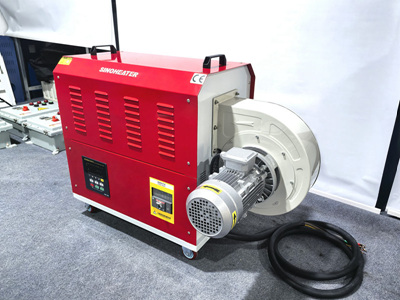Precision Heating Techniques for Metal Surface Coating Curing Using Hot Air Blowers
Metal surface coating curing demands precise thermal control to ensure adhesion, durability, and aesthetic quality. Hot air blowers provide a non-contact heating solution for solvent evaporation, chemical cross-linking, and film formation. This guide explores technical parameters, equipment configurations, and process optimizations for achieving flawless metal coating applications.
Temperature and Airflow Management for Coating Activation
Effective metal coating curing requires balancing thermal input with material properties to prevent defects like blistering or orange peel. Common coatings such as epoxy primers, polyurethane topcoats, and powder coatings have activation temperature ranges of 60–120°C, 80–140°C, and 180–220°C respectively.
Heating Stages:
- Preheating Phase: Gradually raise metal substrate temperature to 50–70°C over 3–5 minutes to eliminate residual moisture and improve coating flow.
- Solvent Evaporation: Maintain 80–100°C for 8–12 minutes to ensure complete solvent removal without coating sagging.
- Cross-Linking Phase: Increase temperature to 120–140°C for 15–20 minutes to trigger chemical reactions in two-component coatings.
- Cooling Phase: Reduce temperature to 40°C at 5–8°C per minute to stabilize the film structure.
Material-Specific Adjustments:
- Epoxy Primers: Heat to 90–100°C for optimal adhesion to galvanized steel.
- Polyurethane Topcoats: Limit heating to 110–120°C to prevent yellowing.
- Powder Coatings: Require 180–200°C for melting and flow-out, followed by 20–30 minutes of curing.
Equipment Configuration for Uniform Curing
Hot air blowers must integrate precision nozzles, thermal sensors, and airflow control systems to achieve localized heating without damaging delicate metal surfaces.
Nozzle Design:
- Conical Nozzles: Direct heat in a 20–45° angle for focused applications on edges or welds.
- Slot Nozzles: Distribute heat across wide metal sheets (e.g., 2×1 m panels) with ±2°C accuracy.
- Deflector Nozzles: Create turbulent airflow to heat irregularly shaped parts uniformly.
Airflow and Temperature Control:
- Variable Speed Drives (VSDs): Adjust blower motor speeds (800–3000 RPM) to match coating thickness.
- Infrared Sensors: Monitor surface temperatures in real-time, triggering automatic blower adjustments.
- Dual-Zone Heating: Combine hot air with infrared lamps for surface curing without overheating interiors.
Workspace Design:
- Insulated Chambers: Retain heat to reduce energy consumption by 15–20%.
- Ventilation Systems: Extract fumes and maintain oxygen levels to prevent solvent accumulation.
- Ergonomic Stands: Position metal parts at 15–30° angles for optimal airflow penetration.
Process Optimization for Defect-Free Coatings
Achieving flawless metal coating curing requires adherence to sequential protocols and defect prevention strategies.
Step-by-Step Application:
- Surface Preparation: Clean metal surfaces with alkaline cleaners to remove oils and rust.
- Initial Heating: Apply hot air at 60–70°C for 2–3 minutes to soften coatings before application.
- Coating Application: Spray or roll coatings evenly across the substrate.
- Flash-Off: Allow 5–10 minutes for solvent evaporation at room temperature.
- Curing: Heat treated areas to 120–140°C for 15–20 minutes to activate cross-linking.
- Final Cooling: Cool assemblies in a controlled environment (40°C) for 5–10 minutes.
Defect Prevention:
- Thermal Shock: Avoid sudden temperature changes by limiting heating/cooling rates to 8°C per minute.
- Uneven Curing: Rotate metal parts 180° every 5 minutes during heating to ensure symmetry.
- Solvent Popping: Pre-dry coatings at 50°C for 10 minutes to eliminate trapped solvents.
Advanced Techniques:
- Hot Air-Infrared Hybrid Curing: Combine hot air for bulk heating with infrared for surface drying, reducing curing time by 30%.
- Pulse Heating: Apply intermittent hot air bursts (e.g., 5 seconds on, 10 seconds off) to prevent overheating.
- Zone Control: Use multiple hot air blowers to create temperature gradients for complex geometries.
Compliance with Safety and Environmental Standards
Metal coating workshops must adhere to regulations to protect workers and reduce ecological impact.
Safety Protocols:
- Personal Protective Equipment (PPE): Wear heat-resistant gloves, goggles, and respirators to handle fumes.
- Emergency Systems: Install automatic shutoff mechanisms for overheating (>150°C) or airflow failure.
- Fire Suppression: Equip workshops with CO₂ extinguishers and sand buckets for rapid response.
Environmental Regulations:
- Emission Control: Use catalytic converters to reduce VOC emissions from heated coatings.
- Waste Management: Recycle overspray and filter airborne particles with HEPA systems.
- Energy Efficiency: Implement heat recovery systems to repurpose exhaust air for preheating.
By integrating these techniques, metal coating specialists can achieve 90–95% success rates in coating adhesion while maintaining compliance with international safety standards. Continuous innovation in hot air blower technology, coupled with rigorous process control, positions metal surface curing at the forefront of industrial efficiency and product longevity.




